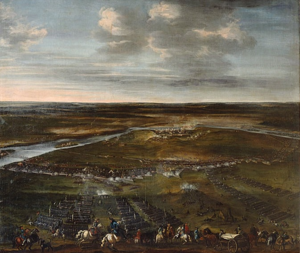
Back معركة نارفا Arabic Narva döyüşü Azerbaijani Нарва янындағы алыш Bashkir Бітва пры Нарве Byelorussian Бітва пад Нарвай (1700) BE-X-OLD Битка при Нарва (1700) Bulgarian Batalla de Narva (1700) Catalan Bitva u Narvy (1700) Czech Schlacht bei Narva German Μάχη της Νάρβα Greek
You can help expand this article with text translated from the corresponding article in Swedish. (October 2022) Click [show] for important translation instructions.
|
| Battle of Narva (1700) | |||||||||
|---|---|---|---|---|---|---|---|---|---|
| Part of the Great Northern War | |||||||||
 The Battle of Narva (1700). Daniel Stawert, 1713 | |||||||||
| |||||||||
| Belligerents | |||||||||
|
|
| ||||||||
| Commanders and leaders | |||||||||
| Strength | |||||||||
|
Narva garrison: 1,800 men, 297 artillery pieces Relief force: 10,500 men, 37 cannons[a] |
33,384[5]–37,000 men 195 artillery pieces[b] | ||||||||
| Casualties and losses | |||||||||
|
667 killed 1,247 wounded[c] |
8,000–9,000 killed, wounded, or drowned[6][7] | ||||||||
|
Notes
| |||||||||
The Battle of Narva (Russian: Битва при Нарве, Bitva pri Narve; Swedish: Slaget vid Narva) on 30 November [O.S. 19 November] 1700 (20 November in the Swedish transitional calendar) was an early battle in the Great Northern War. A Swedish relief army under Charles XII of Sweden defeated a Russian siege force three to four times its size. Previously, Charles XII had forced Denmark–Norway to sign the Treaty of Travendal. Narva was not followed by further advances of the Swedish army into Russia; instead, Charles XII turned southward to expel August the Strong from Livonia and Poland–Lithuania. Tsar Peter the Great of Russia took Narva in a second battle in 1704.
- ^ Kerala J. Snyder (2002), p.137. Oxford University Press, USA. 28 June 2002. ISBN 978-0-19-803293-9. Archived from the original on 2023-11-30. Retrieved 2015-12-13.
- ^ "Magnus Stenbock Count and Spy". Archived from the original on 2018-06-14. Retrieved 2012-07-19.
- ^ Essen, Michael Fredholm von (June 2024). Peter the Great's Disastrous Defeat: The Swedish Victory at Narva, 1700. HELION & Company. ISBN 9781804514436.
The battle had the immediate effect of the Russians evacuating the whole of Ingria.
- ^ a b c d e f g h Cite error: The named reference
Black111was invoked but never defined (see the help page). - ^ Shkvarov 2012, p. 203.
- ^ a b Bergman, Lisa (2021-04-21). "Slaget vid Narva". Historiska Media (in Swedish). Retrieved 2024-03-07.
- ^ "Slaget vid Narva". www.tacitus.nu. Retrieved 2024-03-07.
- ^ Grey, Ian (2015). Peter the Great. New Word City. ISBN 978-1-61230-922-4. Archived from the original on 2023-11-30. Retrieved 2020-11-24.
- ^ Christer Kuvaja (2008), p.139
- ^ Lars-Eric Höglund, Åke Sallnäs, Alexander Vespalov (2011). Great Northern War 1700–1721, II.
- ^ Generalstaben (1918–1919). Karl XII på slagfältet.
- ^ "Tacitus.nu, Örjan Martinsson. Russian force". Archived from the original on 2018-08-31. Retrieved 2013-09-07.
- ^ a b c d Boris Grigorjev & Aleksandr Bespalov (2012). Kampen mot övermakten. Baltikums fall 1700–1710. pp. 38
- ^ a b Cite error: The named reference
ullgrenwas invoked but never defined (see the help page). - ^ Cite error: The named reference
Svenska slagwas invoked but never defined (see the help page). - ^ Cathal J. Nolan (2008). Wars of the Age of Louis XIV, 1650–1715. pp. 313
- ^ Hughes, Lindsey. Russia in the Age of Peter the Great. — New Haven: Yale University Press, 1998. pp. 30.
- ^ Olle Larsson, Stormaktens sista krig (2009) Lund, Historiska Media. pp. 99